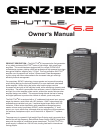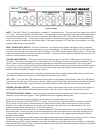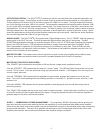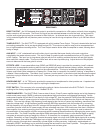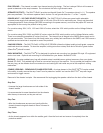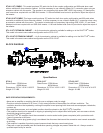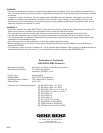
FRONT PANEL
INPUT – The SHUTTLE
®
6.2 is equipped with a standard ¼” unbalanced input. The input sensitivity range is from 40 mV
to 1.6 volts. The input impedance is >500K ohms. The input stage contains a precision high order active high pass lter
(more effective and less intrusive than the more common 6 dB lters) and an “RFI” lter (radio frequency interference)
to eliminate unwanted noise. The input gain stage consists of a feedback type variable gain circuit that provides wide
range, continuously variable gain with minimal noise. The preamp contains a FET input amp circuit based on our highly
regarded GBE series touring ampliers.
INPUT SIGNAL MUTE SWITCH – With this mute switch, you can place the amplier (and Direct Output) in standby
mode between sets, without having to change any of your amp settings. This feature can also be used for silent tuning
since the Tuner Out stays active when the mute is engaged. A red LED indicates when the Mute is active. This function
is also foot-switchable from the optional 4 button foot switch. The switch on the amplier’s faceplate must be in the “out”
position for the foot switch to work properly.
PREAMP GAIN CONTROL – This control sets the input sensitivity gain of the 12AX7 TUBE preamp to the output of
your bass. The volume of the signal is then controlled by the Tube Preamp Volume control and also the Master Volume
control. Note that overdriving the input tube gain stage may be a desirable tonal characteristic of your playing style.
This control, in conjunction with the Preamp and Master Volume controls, allows you to set the amount of tube overdrive
or clean tone your amp produces. The Gain structure is set in such a way that using the control beyond the 3 o’clock
position will provide dramatic increase in tube overdrive.
***It is generally recommended when using heavily distorted tones with a tweeter loaded cabinet, that you reduce the
high frequency settings on the amp or cut the tweeter level control of your cabinet.
“O/L” LED – This “Over-load” LED senses the operating status of the preamp and EQ stages. When this LED ashes,
overdriving of the input gain or EQ stage is occurring. Adjusting the Preamp Gain, Preamp Volume and EQ controls will
affect the over-load condition. Again, overdriving the tube pre-amp may be a desirable tone for your playing style.
PREAMP VOLUME CONTROL – This control sets the volume of the preamp after the Input and Tube Gain stages but
before the EQ, Signal Shape and Master Volume controls. Use this control in conjunction with the Gain Control.
SETTING YOUR INPUT SIGNAL – Use the following guidelines to set your amplier input stage for the type of bass
used and your personal playing style. These guidelines are just a suggested starting point.
1) Set your instruments controls (volume and tone) where you normally prefer to run them.
2) Now set all controls on the SHUTTLE
®
to 12 o’clock. It may be best to start with the Master Volume at 9 o’clock.
3) For a clean tone and using a Passive bass your Tube Gain and Preamp Volume settings may be set to similar
positions. For a clean tone using an Active bass your Tube Gain setting should be set more towards the 9 o’clock
position and the Preamp Volume at noon to 2 o’clock positions.
4) For overdriven tube tones with Active or Passive basses your Tube Gain setting will be set higher and the Preamp
Volume set lower. If driving the Gain Control towards maximum then the Preamp Volume should be set below the 12
o’clock position. Set your Master Volume for your desired overall volume. We suggest experimenting with different
settings for best results.
5) Now, turn your attention to the EQ section and make the adjustments for your desired tone. Because this is an active
EQ network, any larger settings of cut or boost will affect the gain level of the preamp and the O/L light.
6) After setting your EQ it may be necessary to go back and adjust your input gain level down accordingly. It should be
noted that the Global Signal Shape circuits will not affect the input gain BUT will affect the Master output level and PEAK
indicator if used with extreme settings.
2



